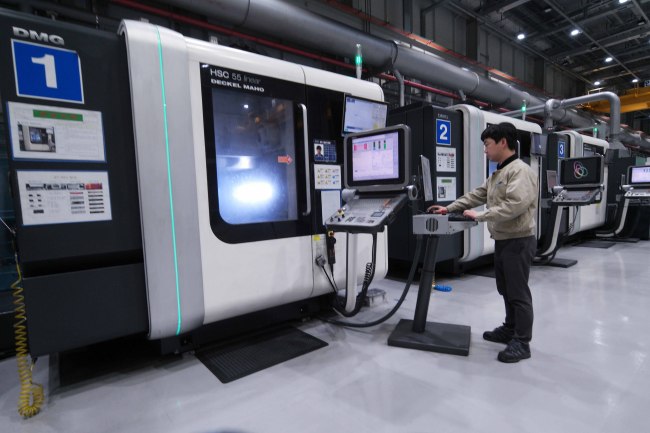Samsung
A peek into Samsung’s smart manufacturing
[THE INVESTOR] GWANGJU -- Stepping inside one of Samsung Electronics' plants for air conditioners and air purifiers in Gwangju, visitors can see the usual scene of workers fixing parts with automatic screwdrivers and other handheld devices along assembly lines.
There is, however, something different about these facilities where Samsung churns out its signature Wind-Free Air Conditioner.
Compared to traditional assembly lines where each worker does only one repetitive task, such as fastening bolts and nuts, workers at these assembly lines work more like “craftsmen.”
They do multiple tasks, including monitoring quality control systems and assembling not just one, but different components before the finished products roll off the lines.
 |
Workers assemble air conditioners inside a factory at one of Samsung Electronics’ industrial complex in Gwangju City on April 18. |
Samsung calls this process with skilled assemblers a “module production system.”
Together with a fully automated system featured in the early production stage, the process has helped improve the production capacity of air conditioners by 25 percent, Samsung said.
“An MPS in which each worker/expert takes charge of nearly the entire assembly process has been adopted for the first time in the electronics industry,” Choi Choong-sik, a Samsung official from one of the firm’s three manufacturing complexes in Gwangju, told a group of visiting reporters.
The official explained that MPS and the automated system have played a key role in lowering the rate of defective products by 50 percent.
“Previously, if one worker made a mistake while tightening bolts at a line, for example, all the products on the same line had to be retrieved and checked to fix the defect, but there is no chance for such thing occurring now.”
Also helping to reduce the defect rate is a 3-D scanning system that automatically checks the air conditioners with high-definition cameras to detect dirt, scratches, gaps in the chassis and uneven color on the surface.
The 3-D scanners featured in the final stage of the assembly process can monitor if there is any defect among 135,000 tiny holes, measuring around 1 millimeters in diameter, punctured on the metal body case of the Wind-Free Air Conditioner.
Among other up-to-date technologies that make the Samsung factory smarter and more efficient is a virtual training course for new workers. They attend a two-week course in which they learn the ropes by virtually handling machines and assembling parts on a large interactive screen.
Though Samsung declined to reveal the defect rate, electronic boards installed in the factory that display the daily production target and defect rate of the assembly lines showed that there was no faulty product among some 1,300 air conditioners and air purifiers built at two assembly lines during the day on April 18.
Through such efforts to increase efficiency and produce impeccable goods, Samsung has been meeting the surging demand for its Wind-Free Air Conditioner, which has been hugely popular in Korea, where customers prepare for the sweltering summer season months in advance.
Launched in January 2016, sales of the floor-standing air conditioner crossed 350,000 units in March this year, and is forecast to rise before heat waves hit the nation in earnest. It has gained popularity especially because it cools the room by dispersing cold air gently through the tiny holes and keeps the temperature low by creating still air, compared to a conventional air conditioning system that directly blows cold air.
 |
A worker monitors a molding machine at Samsung Electronics’ R&D center for high-precision molding technology. |
The air conditioner’s exterior design with numerous tiny holes, a key feature for the Wind-Free technology, was made possible thanks to advanced molding techniques developed at the tech giant’s research and development center at a Samsung industrial complex in the city.
The R&D center fitted with automation systems that is run around the clock develops molds for most of the firm’s premium home appliances such as the Chef Collection refrigerator, and curved TVs. It shares the molding technology and related assembly techniques with Samsung’s global manufacturing sites and partners. The company plans to transform the mold-making facilities at the center into fully automated ones by 2020.
Samsung said its top-tier automated assembly and mold-making processes are the two drivers that will help it have a competitive edge in the global market.
It plans to roll out marketing events for the floor-standing air conditioner, as well as its new wall-mounted version of the air conditioner, in the global market from this month.
“The Gwangju complex is the manufacturing hub of Samsung’s premium home appliances,” said Jung Kwang-myoung, vice president of Samsung who oversees the plants in the city, “All executives and employees will try to meet the expectations of consumers with great products.”
By Kim Young-won (wone0102@heraldcorp.com)








